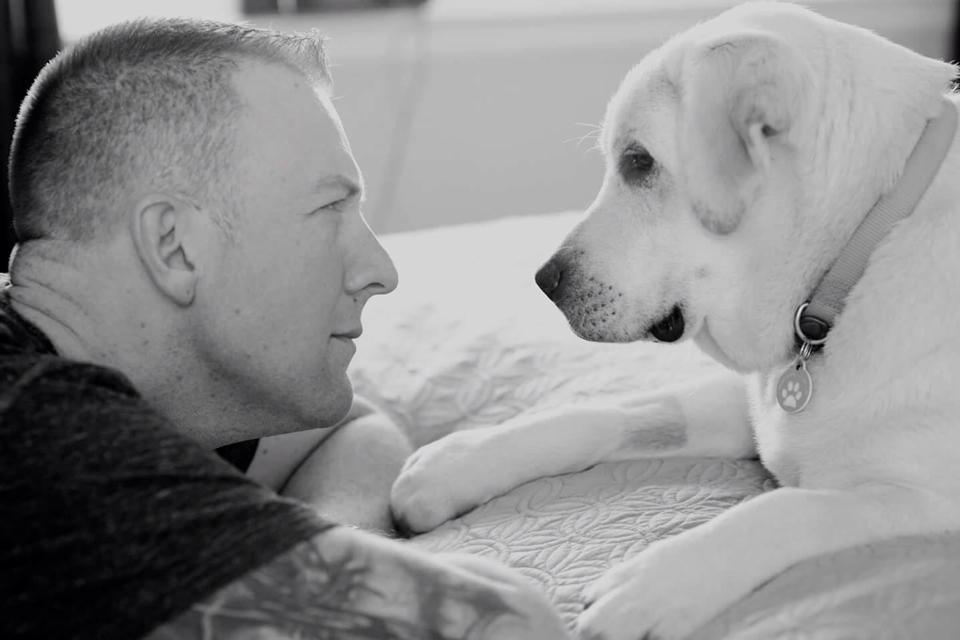How Labrador Retrievers are Making Life More Livable for Veterans with PTSD
By Tina Russo Kinney
A reported 22 veterans a day lose their lives to suicide because of PTSD (Post Traumatic Stress Disorder). This number is configured based on the 23 states who report veteran suicides. If all 50 states reported, the number would probably be closer to double. Essentially, America is losing more veterans to suicide than the war in the Middle East. Veterans returning from war, most of whom have been in combat situations, deal with flashbacks, loss of hope and enjoyment of life, nightmares, anger, depression, and anxiety. Some of this is due to witnessing and participating in combat, while some relate to disabilities stemming from physical injuries sustained while in combat. While there are many other symptoms with PTSD, these seem to be more prevalent among veterans returning from war. With a currently limited number of treatment options for PTSD, more veterans and their physicians are turning to service dogs to help veterans deal with their diagnosis.
Often, when veterans return from war, they are not prepared for everyday life. “We are trained to fight and battle war. No one trains you for the transition back into society when your deployment is over,” says Sergeant William Coash, a Purple Heart recipient, who served eight years in the United States Marine Corps. Coash completed four deployments in the Middle East and was diagnosed with PTSD. Service dogs are being used to help get veterans back to living their lives. Many veterans with PTSD tend to stay away from activities they once enjoyed such as family gatherings or events where large crowds are present because it triggers their symptoms.
“Many veterans cannot do things they did before deployment,” explains Ken Knabenshue, Army veteran and founder of Working Dogs for Vets. Ken works as a trainer for dogs of all breeds and matches trained service dogs with veterans who have been diagnosed with PTSD. “I was tired of losing so many of my friends and family to suicide because of PTSD, so I decided to do something about it,” Knabenshue explains. “I have always worked with dogs, so training them for veterans with PTSD was a natural fit for me.” Knabenshue runs the organization with his wife Brenda. Together they have set up a system of dog training where veterans across the country are helping other veterans.
“We have a goal of matching 100,000 dogs with 100,000 veterans. To do this, we use veterans who have received a dog from us to help other veterans in their geographical area also get and train service dogs. It’s all about veterans helping veterans. My wife and I cannot train all these dogs ourselves, so we enlist in the help of veterans. It is very empowering for these veterans to help others who are going through the same things they have gone through,” Knabenshue says.
While dogs are known as “Man’s Best Friend,” service dogs are properly trained for 12 – 14 months to do more than be a best friend. “We train these dogs to be more than just companion animals. These dogs can do things ranging from turning lights on and off, retrieving medications and beverages to take medications with, assisting [veterans] with stairs, opening doors, and calming them down during a panic attack.” Well-trained service dogs can also wake a veteran who is having a nightmare, or find an exit and assist their veteran in leaving a high-stress situation.
While many breeds of canines can work well for a service dog, Labrador retrievers are known to learn commands quickly and efficiently during training. They are also a popular breed, making them available to enter training programs. The dogs used for service dogs come from a variety of places including breeders and shelters.
Tasks that can hinder veterans and cause them to prefer to stay at home can be easily accomplished with the aid of a service dog. Going to the ATM for example, could cause someone with PTSD anxiety because they have their back to the world while facing the machine. “During combat, military personnel are trained to ‘have their partners’ back,’ meaning, there is a lookout always keeping watch. When you come home, there is no one watching your back to protect you and warn you of danger,” explains USMC Sergeant Coash. Having a service dog know and execute the “watch my back” command, where the dog stands behind their companion and moves his or her head on a swivel, making it possible for someone with anxiety to complete the task of visiting an ATM because the dog is “on watch.”
Other tasks, such as visiting a child’s school are often not an option for someone with PTSD, but dogs are changing this reality. “There are days when I want to give up training, because it is a lot of work and money. We do not charge the veterans for their dogs, because most of them do not have the kind of money it takes. We depend on donations, fundraisers and help from the public. Then I get a phone call from a son or daughter, telling us their mom or dad was able to come to a school function or game with the help of their service dog for the first time in years, and it all becomes worth it,” says Knabenshue.
As more veterans continue to return from war and be diagnosed with PTSD, people such as Knabenshue are working hard to train dogs so veterans can return to life much like it was before their deployment. Service dogs are not a cure for PTSD, but with no known cure, service dogs are helping veterans live a better life and return to activities they once knew and enjoyed. Because of service dogs, veterans are gaining their independence back and finding hope in their lives. For people like Ken Knabenshue, he believes this will help change the statistics and the number of veterans who feel like their only answer is to take their own lives.







